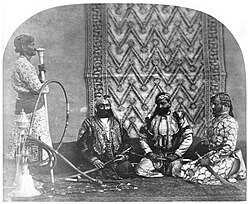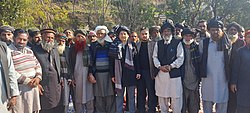Gurjar
Gurjar or Gujjar (also translitterated as Gurjara [1], Gujar, Gujjara and Gurjjar) are a peasant, pastoral and agricultural[2] ethnic community, having a reputation for their warlike behavior in past,[3] residing mainly in India, Pakistan, Nepal, and Afghanistan,[4] divided internally into 1788 to 2000[5] clan groups. They are an agricultural and pastoral group of Jammu and Kashmir, Northwestern India, northern and central Pakistan, Azad Kashmir and northeastern Afghanistan.[6]
| Gurjar, Gurjara, Gujjar | |
|---|---|
| Ethnicity | |
| Ethnicity | Punjabi, Kashmiri, Gujarati, Sindhi, Haryanvi, Marathi |
| Location | South Asia |
| Language | Punjabi, Kashmiri, Hindi-Urdu, Gujarati, Sindhi, Haryanvi, Gojri, Pashto, Balochi |
| Religion | Islam, Hinduism, Sikhism |
| Surnames | Chaudhary, Choudhary |
The Gujari language is closely related to Rajasthani and Marwari. As per historical accounts parts of Rajasthan and Gujarat were known as Gurjarah-bhumi or Gurjaratra prior to Mughal period in India.[7][8]
However, in later times, circa the 14th century AD onwards, they were reduced to small principalities due to successful invasions and conquests by Muslim powers in northern and western India. During the 15th-16th century, there were Gurjars in the areas of Meerut and Dadri. The Gurjars in Pakistan and Afghanistan are Muslim.[9]
After this time, with struggles against the rising Mughal power and later British India the Gurjars gradually fell into a decline. They became poor nomads and started living in jungles and forests. With Muslim rule in North India, the Hindu Gurjars of the area surrounding Delhi had to live in jungles in order to save their Hindu faith and to survive.
Geographical Distribution
Today, Hindu Gurjars are found in the Indian states of Rajasthan, Haryana, Western Uttar Pradesh and to a smaller extent Punjab. Muslim Gurjars are found in the Indian states of Uttarakhand, Himachal Pradesh, Jammu and Kashmir and in the Pakistani provinces of Punjab, Azad Kashmir, Khyber Pakhtunkhwa and in the Afghanistan province of Nuristan.
Gurjar Media
Fairs of Shri Devnarayan Bhagwan are organized two times in a year at Demali, Maalasheri, Asind and Jodhpuriya
Statue of Sri Sawai Bhoj Bagaravat, one of the 24 Gujar brothers collectively known as Bagaravats, at Dev Dham Jodhpuriya temple.
Taukeer Alam sharing the Van Gujjar wedding rituals and clothings
Related pages
Reference
- ↑ Mayaram, Shail (2017). "The Story of the Gujars". In Vijaya Ramaswamy (ed.). Migrations in Medieval and Early Colonial India. Taylor & Francis. p. 67. ISBN 978-1-351-55825-9.
The heterogeneous category that is variously called gujar/Gujjar/Gurjara.
- ↑ Zelin, Madeleine (2015-10-06). Merchant Communities in Asia, 1600–1980. Routledge. p. 148. ISBN 978-1-317-31789-0.
- ↑ Wilson, Jon (2016). https://www.google.co.in/books/edition/India_Conquered/DHEQCwAAQBAJ?hl=en&gbpv=1&dq=gujar+warlike&pg=PT279&printsec=frontcover. India Conquered Britain's Raj and the Chaos of Empire. Simon & Schuster UK. ISBN 9781471101274.
Gujars , belonging to a community of cattle herders who had a reputation for their warlike behaviour
{{cite book}}: Check date values in:|year=(help);|chapter-url=missing title (help)CS1 maint: date and year (link) - ↑ Rahi, Javaid, ed. (2012). The GUJJARS - A Book Series on History and Culture of Gujjar Tribe. Vol. 1.
- ↑ Govind Sadashiv Ghurye (1969). Caste and Race in India. Popular Prakashan. pp. 232–. ISBN 978-81-7154-205-5.
- ↑ Pandey, Aditya (2005). South Asia: Politics of South Asia. Gyan Publishing House. ISBN 978-81-8205-303-8.
- ↑ Ramesh Chandra Majumdar; Achut Dattatrya Pusalker, A. K. Majumdar, Dilip Kumar Ghose, Vishvanath Govind Dighe, Bharatiya Vidya Bhavan (1977). The History and Culture of the Indian People: The classical age. Bharatiya Vidya Bhavan. p. 153.
{{cite book}}: CS1 maint: multiple names: authors list (link) - ↑ Keay, John (2000). India: A History. Grove Press. pp. 95, 2001. ISBN 978-0-8021-3797-5.
- ↑ Singh, David Emmanuel (2012-08-31). Islamization in Modern South Asia: Deobandi Reform and the Gujjar Response. Walter de Gruyter. ISBN 978-1-61451-185-4.






